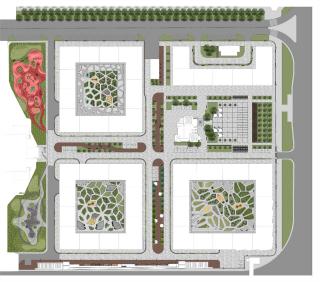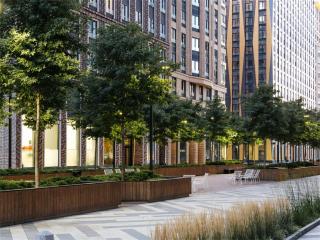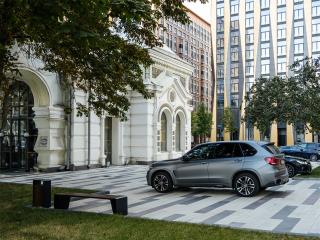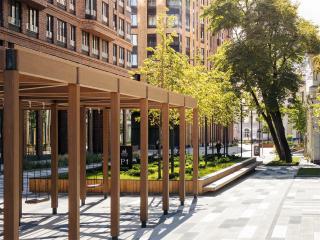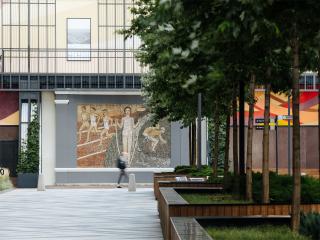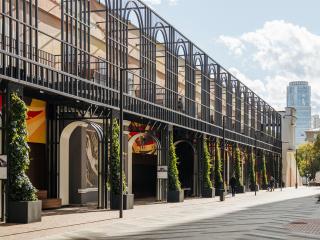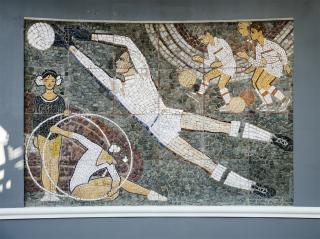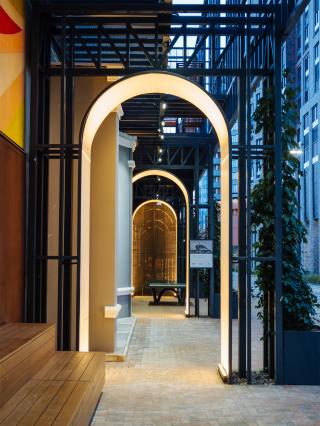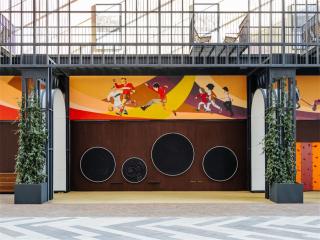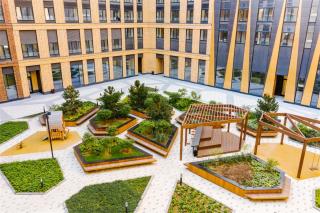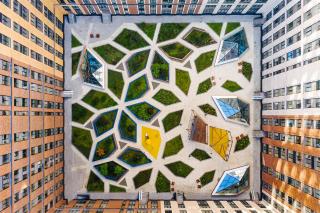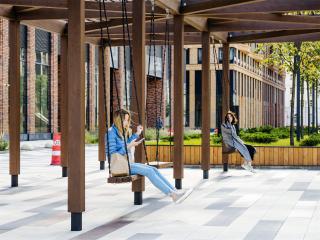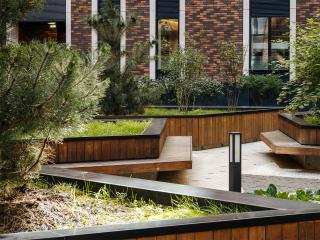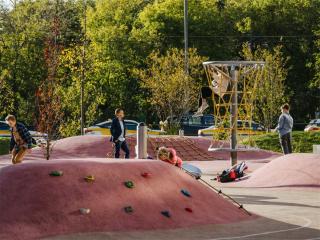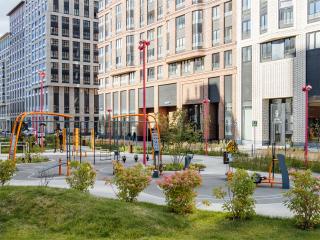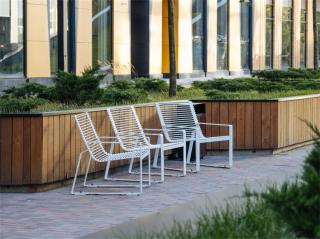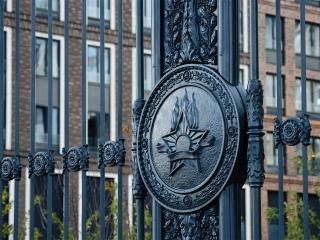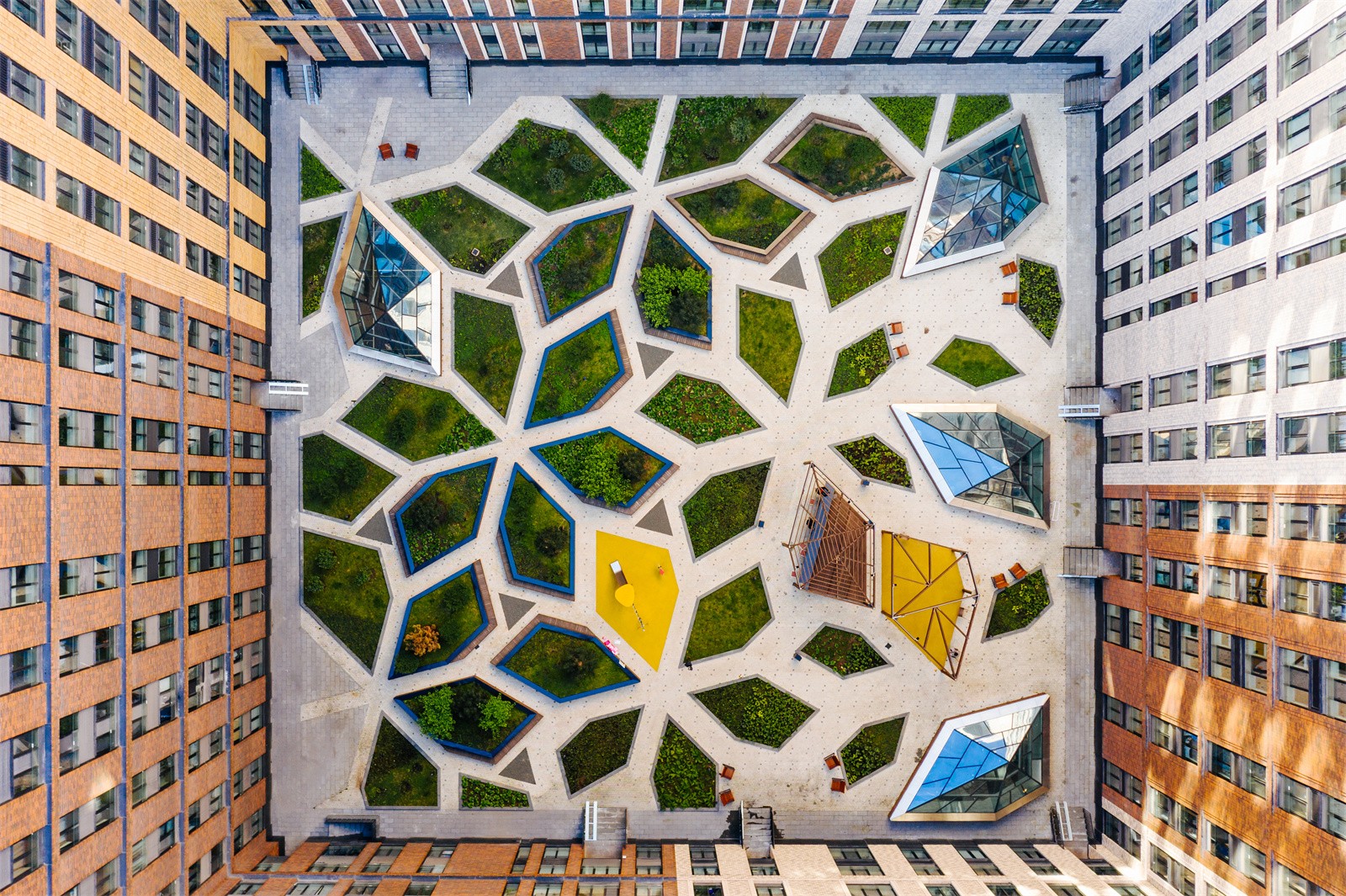
Tsarskaya ploschad住宅綜合體項(xiàng)目由三個(gè)相對(duì)封閉的街區(qū)組成,包括幾棟多層建筑物和一幢獨(dú)棟21層建筑物��。該項(xiàng)目因規(guī)劃范圍囊括了歷史文化遺址而受到廣泛關(guān)注�����,這也是項(xiàng)目的一大亮點(diǎn)���。規(guī)劃團(tuán)隊(duì)首先修復(fù)了坐落在場(chǎng)地原址上的少先隊(duì)體育場(chǎng)建筑遺址。
設(shè)計(jì)任務(wù):打造新型的庭院景觀�����,同時(shí)為住宅綜合體及相鄰住宅的居民創(chuàng)建具有吸引力的公共空間��。
設(shè)計(jì)手法:保護(hù)文化遺址,并將其納入空間整體規(guī)劃之中����,將庭院改造為綠色花園,為全年齡段的人群提供豐富多樣的基礎(chǔ)設(shè)施���。
開(kāi)發(fā)區(qū)域的體塊及空間組成����,根據(jù)其可達(dá)性明確區(qū)分為幾種不同類型的空間:私人庭院��,帶有兒童活動(dòng)場(chǎng)與體育運(yùn)動(dòng)區(qū)的開(kāi)放式林蔭大道��,以及沙皇館前的廣場(chǎng)�����。
建筑物之間的步行道上裝點(diǎn)著有楓樹(shù)的種植池�。道路上鋪設(shè)了鑲花圖案的大瓷磚,在視覺(jué)上統(tǒng)一了住宅綜合體的外部空間��。步行道的中心部分以弗蘭德磚鋪裝來(lái)突出展示�。
The Tsarskaya ploschad residential complex consists of three closed blocks with a varying number of storyes and a separately standing 21-storey building. Its territory is remarkable for including historical and cultural heritage objects, which we wanted to highlight in our project. We restored the fragments of the Young Pioneers stadium, which was located on the site of the complex.
Task: to create a new type of a yard, one that would become an appealing public space both for the residents of this residential complex and the neighbouring houses.
Solution: to preserve the cultural heritage objects and to incorporate them into the general composition of the space, transforming the yard into a green garden with a generous and complex infrastructure available to all age groups.
The volumetric and spatial composition of the development area clearly distinguishes among several types of spaces based on their accessibility: private yards, open boulevards with a kids’ playground and a sports zone, as well as a piazza in front of the Tsar Pavilion.
Along the pedestrian boulevards in between the buildings there are alleys with maple trees in planter boxes. The roads are paved with large tiles with a parquet pattern, which unites visually the outside spaces of the complex. The central parts of the alley are highlighted by the inlaid Flemish brick.
▼建筑物間的步行道上裝點(diǎn)著有楓樹(shù)的種植池
Along the pedestrian boulevards in between the buildings, there are alleys with maple trees in planter boxes. ? Dmitry Tchistoprudov
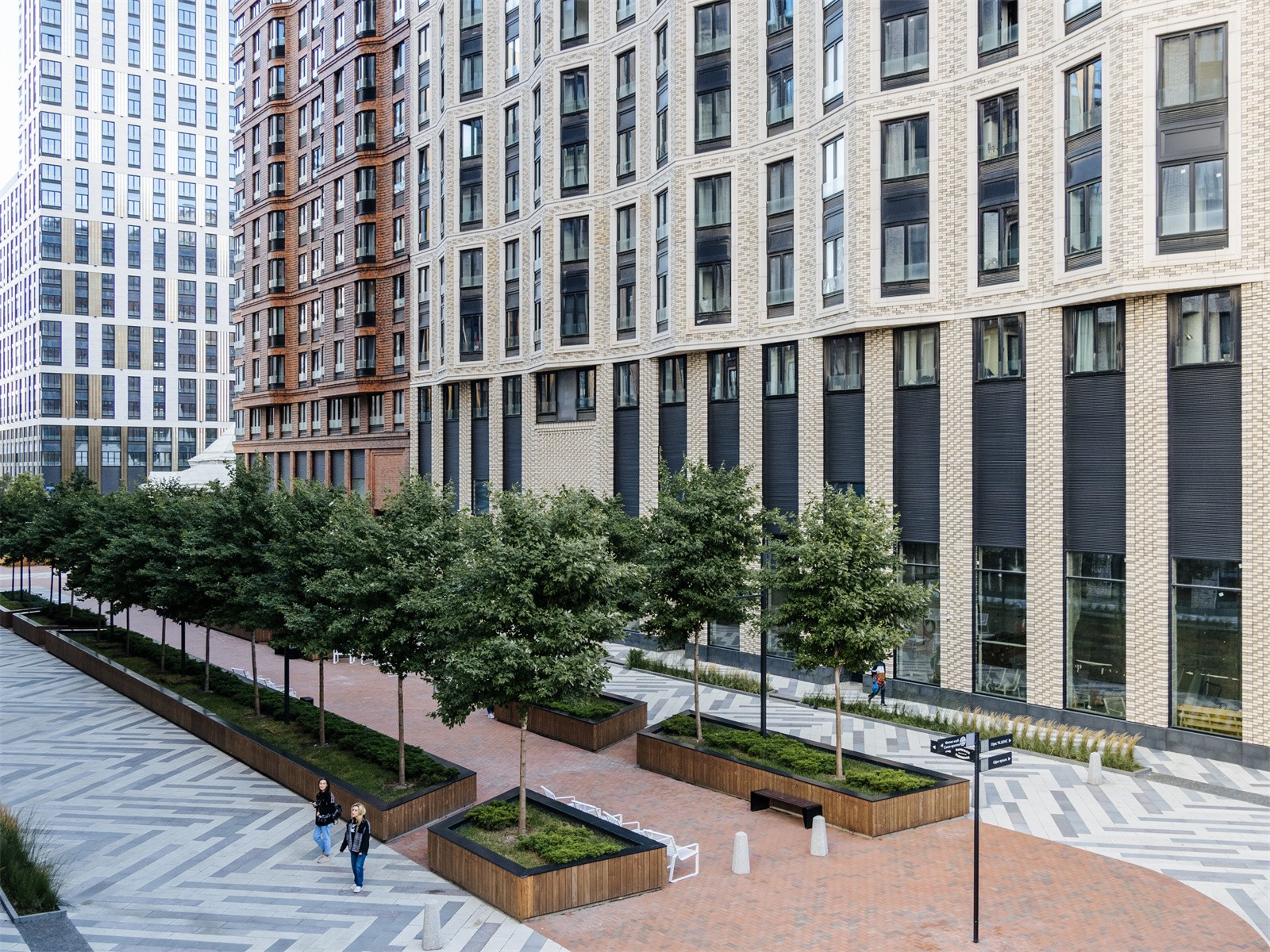

該項(xiàng)目的一大亮點(diǎn)在于如何對(duì)待文化遺址:經(jīng)團(tuán)隊(duì)修復(fù)過(guò)的文化遺址塑造出住宅綜合體的整體形象,使其變得獨(dú)一無(wú)二���。因此����,我們將兩個(gè)時(shí)代的標(biāo)志性建筑納入項(xiàng)目整體規(guī)劃之中,一是可追溯到亞歷山大三世時(shí)期的沙皇館�,另一處是1934年開(kāi)放的少先隊(duì)體育場(chǎng)遺址。
沙皇館建于1882年�����,為慶祝第十五屆俄羅斯工業(yè)藝術(shù)展而筑造�����,沙皇亞歷山大三世也曾參展���。修繕后的展覽館的周邊廣場(chǎng)是該區(qū)域的主要公共空間。不僅住宅綜合體的居民�����,其余大眾也能夠參觀這處文化遺址�。
A peculiarity of this project was the fact we were working with the cultural heritage: the objects restored by us shaped a visual image of the residential complex territory, which made it unique. Thus, we incorporated into the general composition the landmarks dating back to two epochs: the Tsar Pavilion dating back to the times of Alexander III and the fragments of the Young Pioneers stadium, which opened back in 1934.
The Tsar Pavilion was erected in 1882 to celebrate the XV All-Russia Industrial and Art Exhibition, which was to be visited by the emperor Alexander III. The piazza in surrounding the restored pavilion is the main public space of the territory. Not only the residents of the complex but also the public at large have gained access to this cultural heritage.
▼沙皇展覽館
The Tsar Pavilion ? Dmitry Tchistoprudov
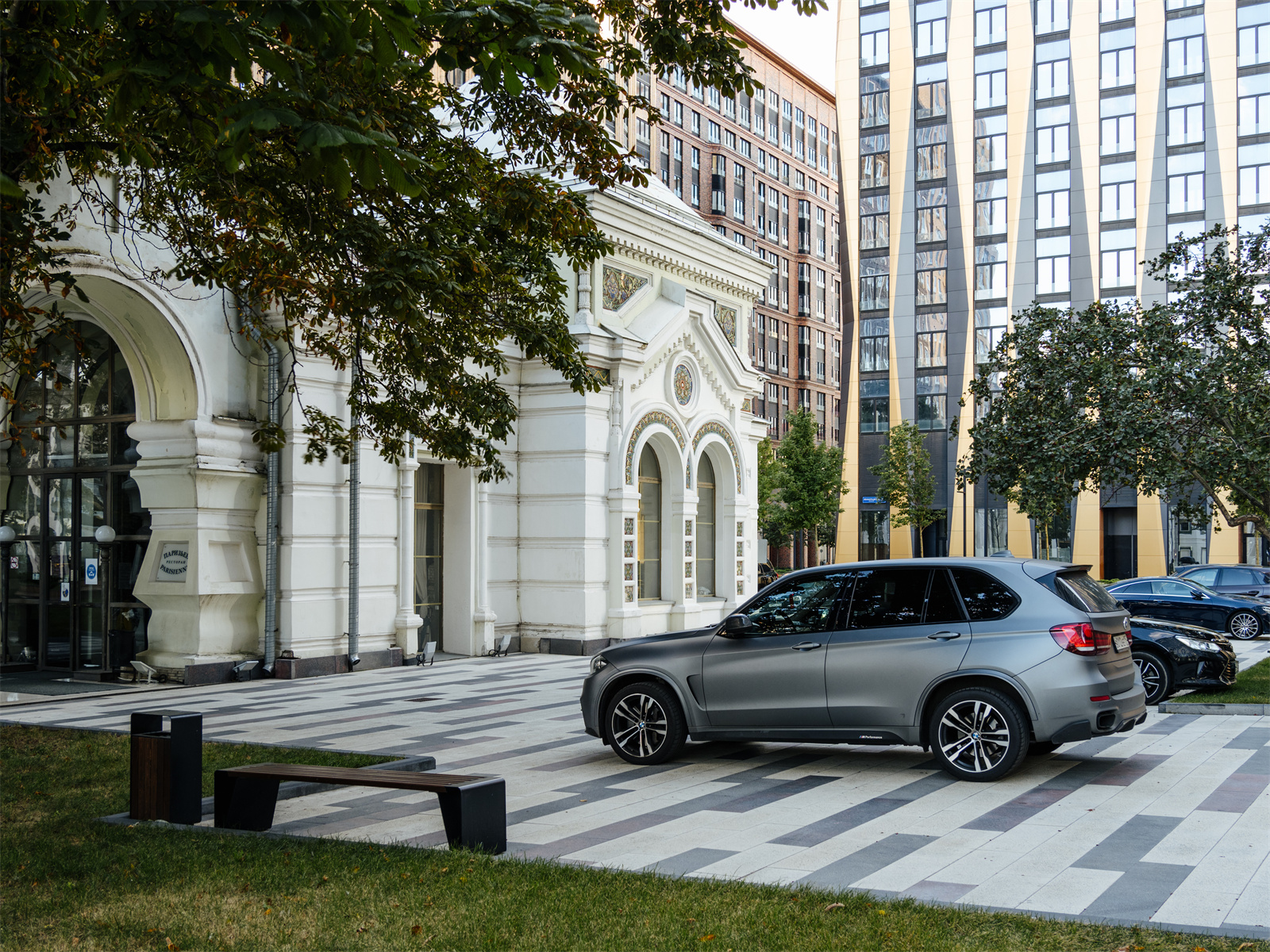
廣場(chǎng)上設(shè)有旱噴裝置,周圍被廊架圍繞�,廊架兩側(cè)懸掛有秋千�����。開(kāi)發(fā)區(qū)域的幾何構(gòu)成設(shè)計(jì)將沙皇館轉(zhuǎn)變?yōu)檎麄€(gè)廣場(chǎng)乃至整個(gè)住宅綜合體的中心焦點(diǎn)�����。通過(guò)這種設(shè)計(jì)手法�,即使從列寧格勒斯基遠(yuǎn)眺�����,展館也清晰可見(jiàn)���。
The piazza accommodates also a dry fountain surrounded by pergolas with swings on both sides. The geometry of the development area turns the Tsar Pavilion into the central object of both the square and the whole complex. The residential complex was designed so as to make the historic pavilion clearly visible from the Leningradsky prospect.
▼廣場(chǎng)上的旱地噴泉裝置
The piazza accommodates a dry fountain. ? Dmitry Tchistoprudov
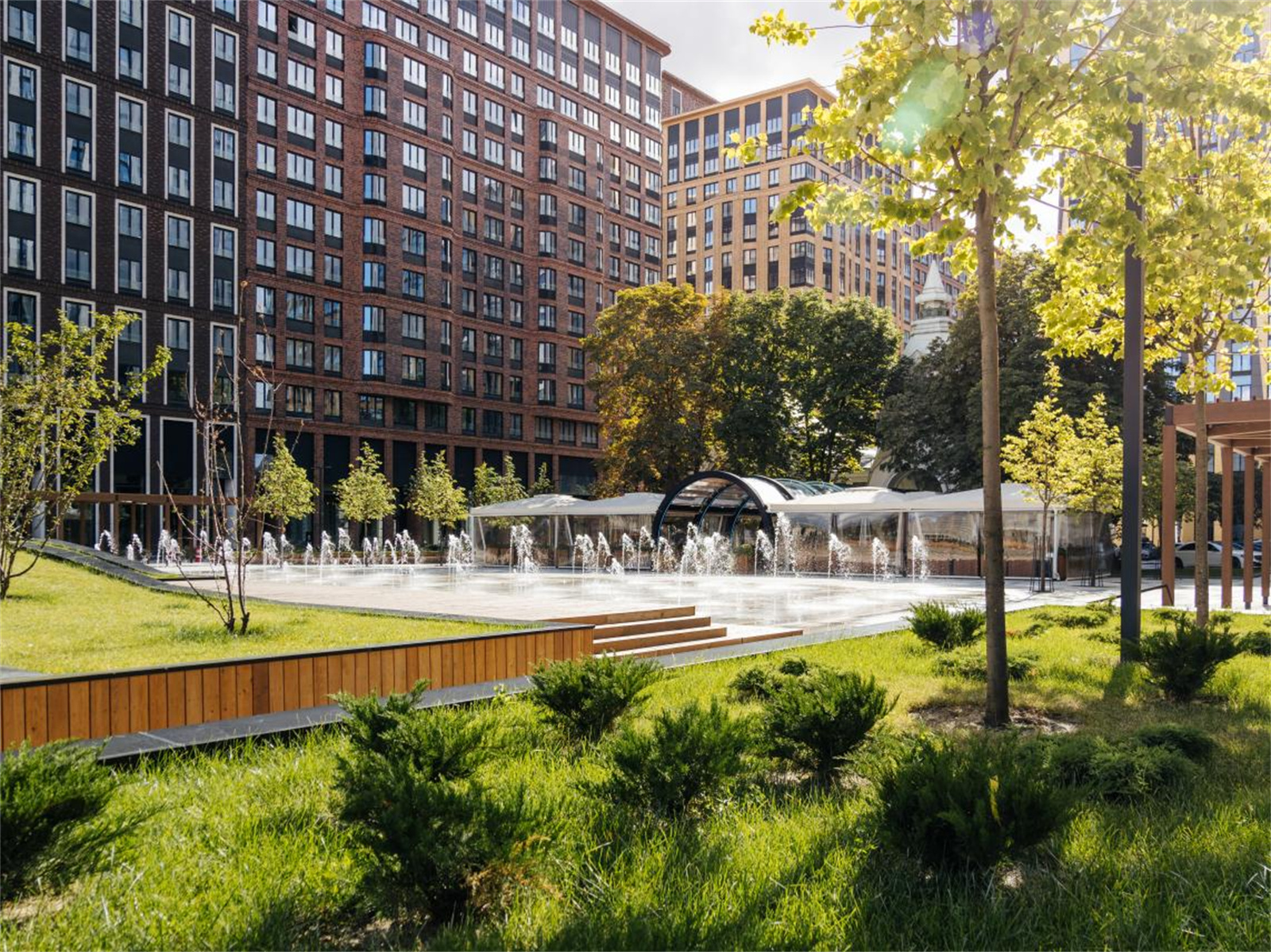
▼廊架兩側(cè)懸掛有秋千
The pergolas with swings on both sides ? Dmitry Tchistoprudov
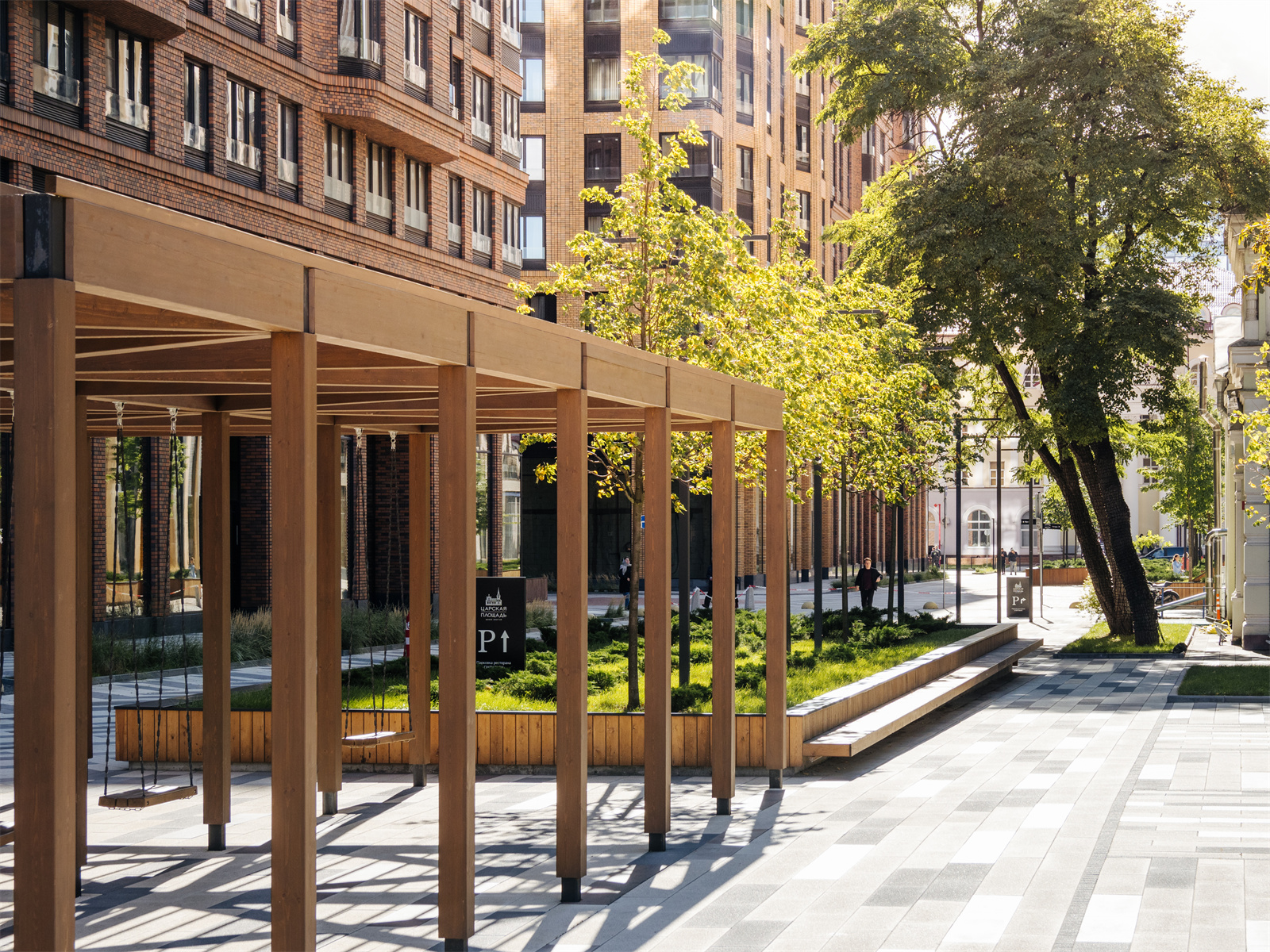
修復(fù)后的前少先隊(duì)體育場(chǎng)的部分墻體�����,將展覽館前的廣場(chǎng)有效隔絕在過(guò)往車輛的噪音污染之外���。我們著重修復(fù)了兩個(gè)關(guān)鍵點(diǎn):一部分墻體和兩塊馬賽克景墻。
作為重點(diǎn)設(shè)計(jì)元素的馬賽克景墻上描繪了兒童使用運(yùn)動(dòng)器材的畫(huà)面�����,周邊區(qū)域圍繞此設(shè)計(jì)展開(kāi)。
The restored fragment of the wall belonging to the former Young Pioneers stadium helps to protect the square in front of the pavilion from the noise of the cars passing by. We were able to restore the key elements of the stadium: a part of the wall and two mosaic panels.
The children with sports equipment depicted in the panels became an essential element based on which we shaped the territory surrounding the mosaics.
▼馬賽克景墻上描繪了兒童使用運(yùn)動(dòng)器材的畫(huà)面
The children with sports equipment depicted in the panels. ? Dmitry Tchistoprudov

直至項(xiàng)目動(dòng)工�,體育場(chǎng)的墻體都還只具備單一的裝飾功能。在項(xiàng)目開(kāi)發(fā)過(guò)程中���,運(yùn)動(dòng)場(chǎng)的墻體上增添了墻欄作為露天吧臺(tái)區(qū)��,以一條步行廊道將保存完好的墻體樓梯與玻璃屋一層的小塊區(qū)域連接起來(lái)��。該結(jié)構(gòu)拓展了綜合體的功能內(nèi)容����,為總覽全區(qū)景觀提供了全新的視角��。
Until recently, the stadium wall used to have only a decorative function. Within the development project a gym wall bars section was added with a pedestrian gallery connecting the preserved stairs of the wall and the small zones at the first level of the glass-house. The structure enlarges the functional content of the complex and gives a chance to see the territory from a new angle.
▼依托運(yùn)動(dòng)場(chǎng)墻體的露天吧臺(tái)區(qū)
The gym wall bars ? Dmitry Tchistoprudov
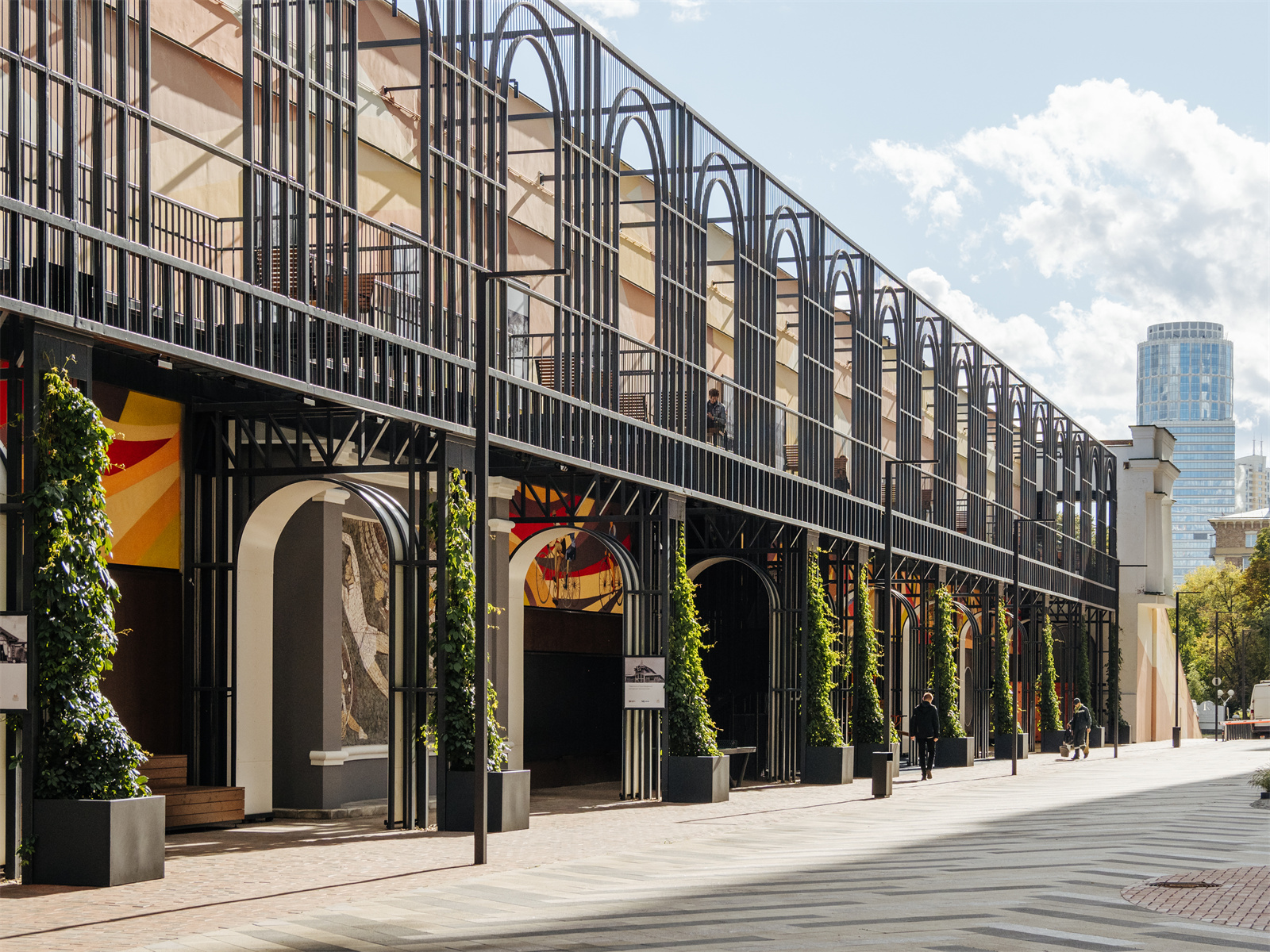
▼吧臺(tái)區(qū)的步行廊道連接著被保留下來(lái)的墻體樓梯
A pedestrian gallery connecting the preserved stairs of the wall ? Dmitry Tchistoprudov
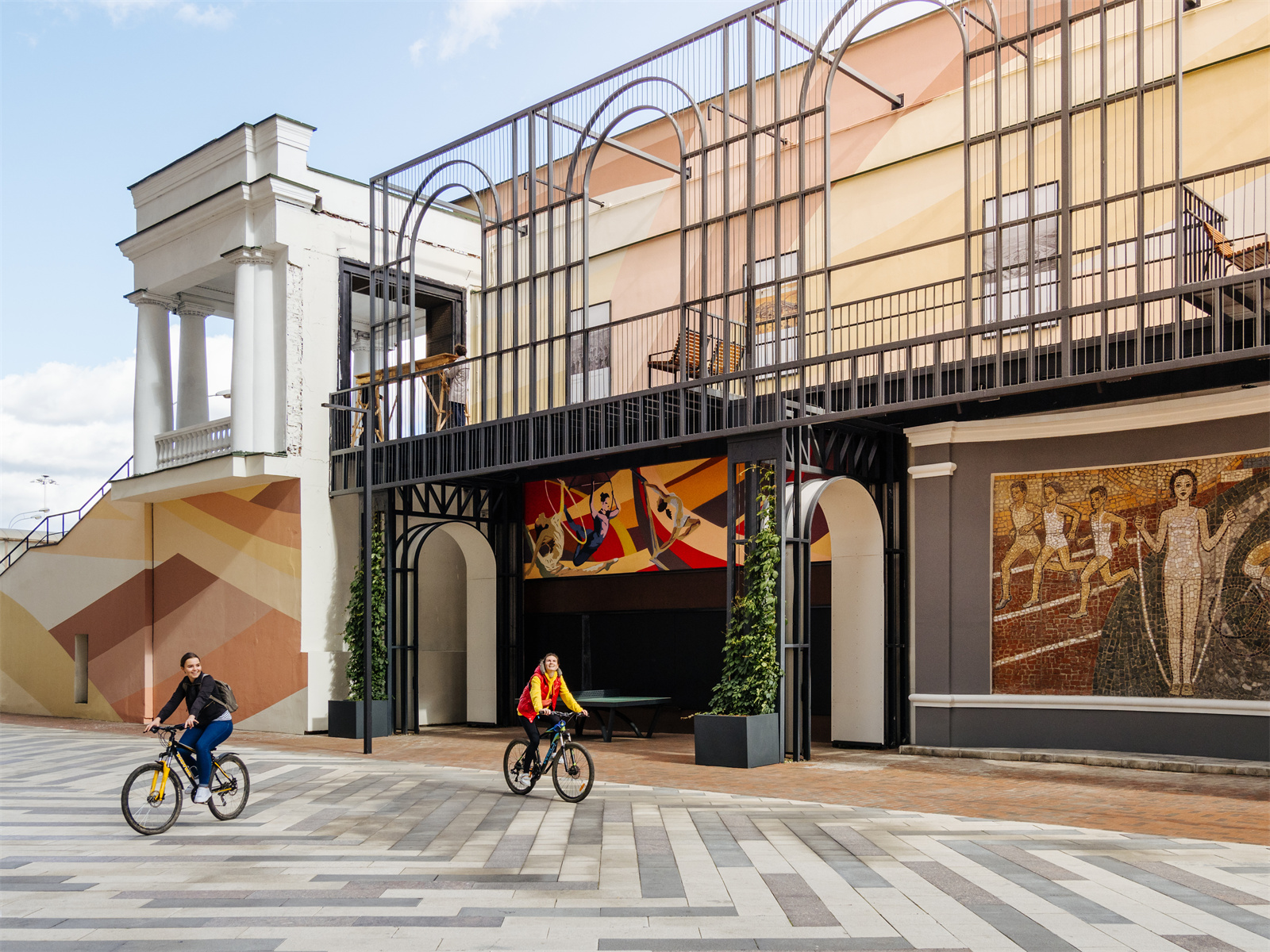
修復(fù)后的蘇聯(lián)馬賽克位于兩座壁龕當(dāng)中�����,在另外的六個(gè)壁龕中�����,每?jī)蓚€(gè)分別用于放置網(wǎng)球臺(tái)���,兒童玩樂(lè)設(shè)施和成人運(yùn)動(dòng)器械�。運(yùn)動(dòng)場(chǎng)的露天吧臺(tái)上還包括兩座露天劇場(chǎng)和一架通往二樓的樓梯�����。
The restored Soviet mosaics are located in two niches, while two other ones accommodated tables for tennis, four more niches have kids and adults sport equipment - each occupying two of these four niches. The gym wall bars include also two amphitheatres and an additional staircase to the second level.
▼修復(fù)后的蘇聯(lián)馬賽克位于兩座壁龕中
The restored Soviet mosaics are located in two niches. ? Dmitry Tchistoprudov
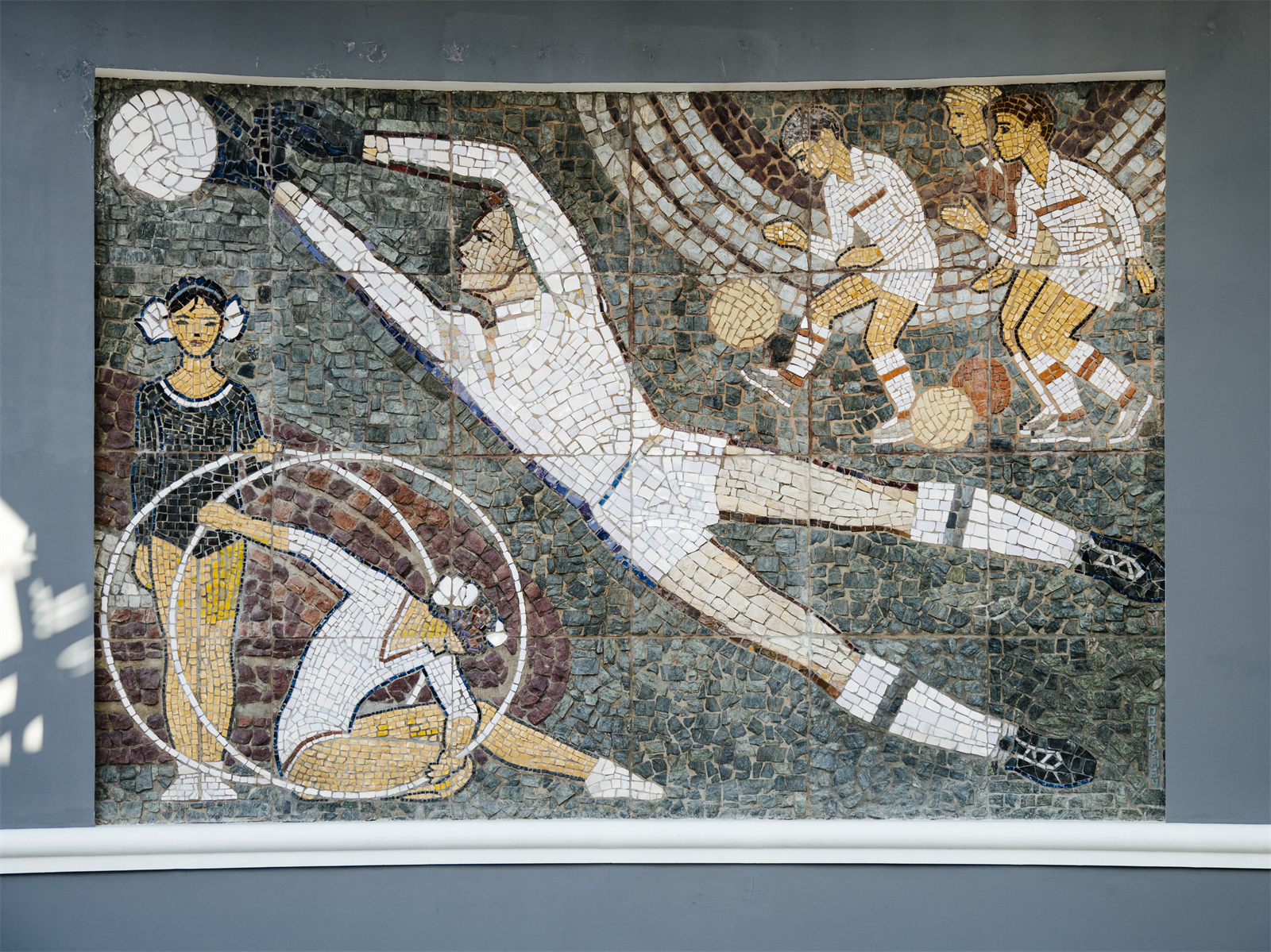

▼放置網(wǎng)球臺(tái)的壁龕
One niche accommodates tables for tennis. ? Dmitry Tchistoprudov
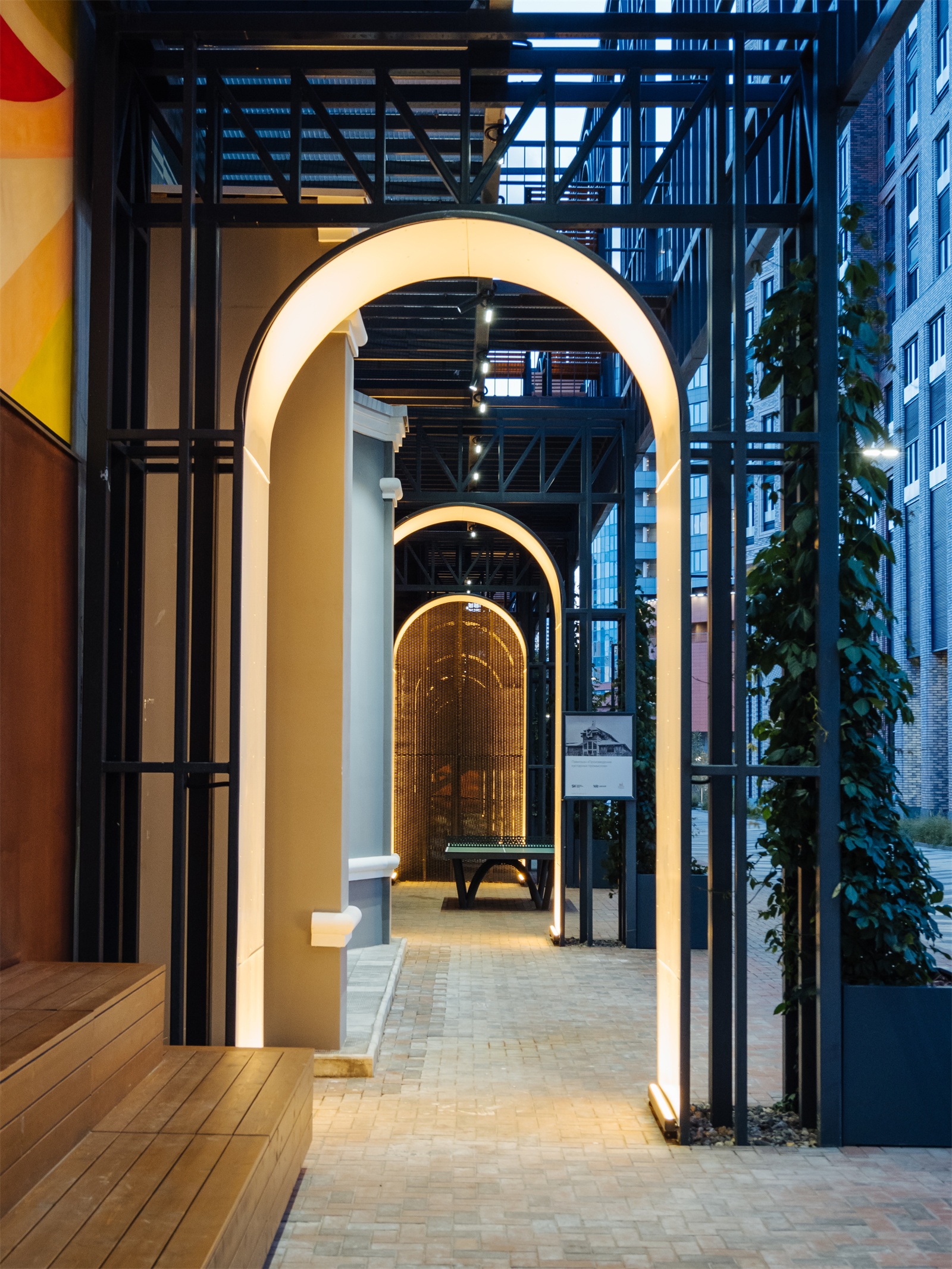
在馬賽克景墻上�����,兒童栩栩如生的人物形象被明亮的涂鴉畫(huà)和運(yùn)動(dòng)器械的對(duì)比細(xì)節(jié)凸顯����。被保存下來(lái)的前少先隊(duì)體育場(chǎng)墻體由Raskrasimvse團(tuán)隊(duì)的涂鴉藝術(shù)家們繪制。
The dynamics of the children’s figures in the mosaic panels is stressed by a work-out zone with some bright graffiti and contrast details of the sports equipment. The preserved wall of the former Young Pioneers stadium was painted by the Raskrasimvse team of graffiti artists.
▼涂鴉畫(huà)和運(yùn)動(dòng)器械
The bright graffiti and the sports equipment ? Dmitry Tchistoprudov
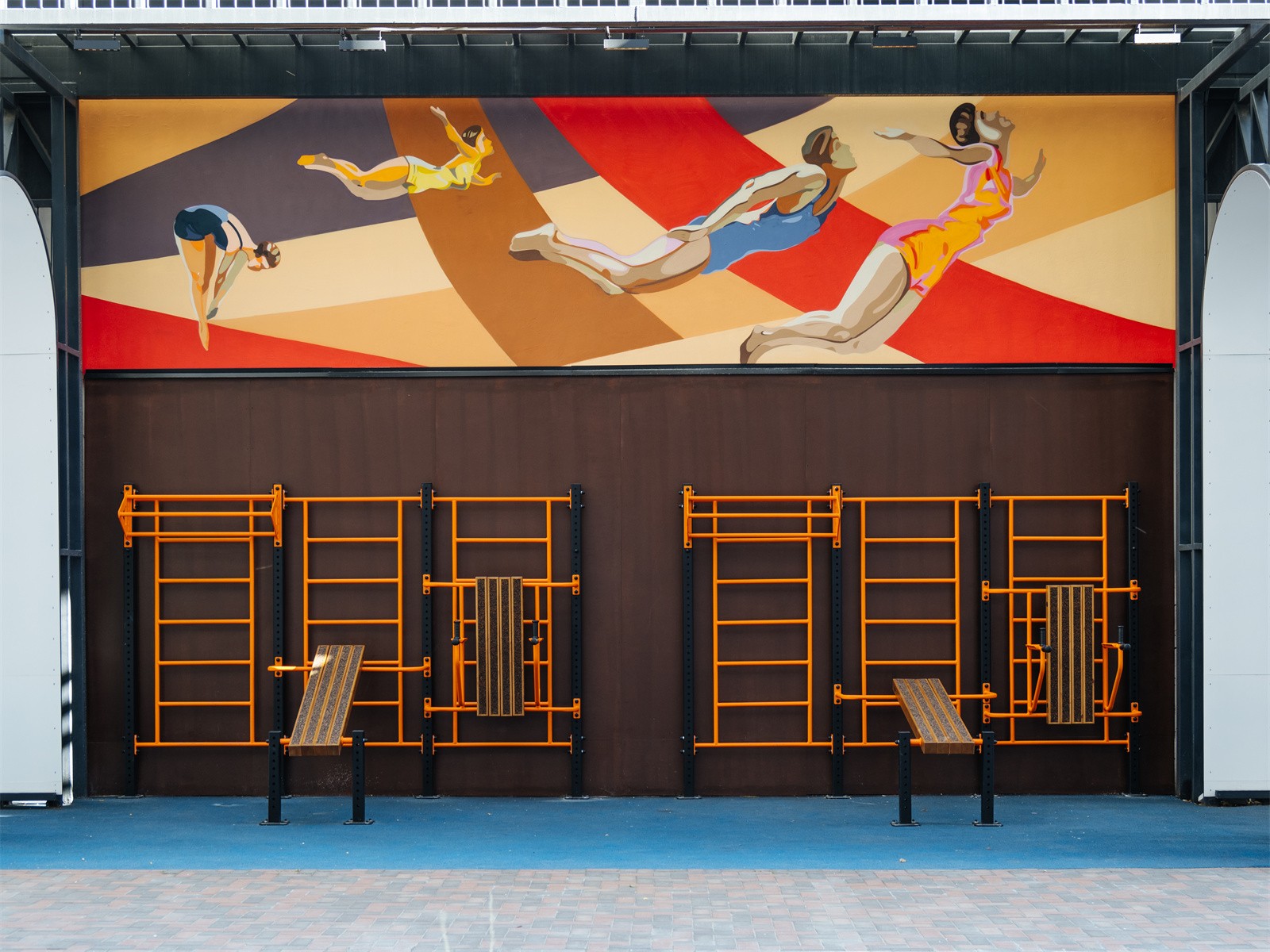
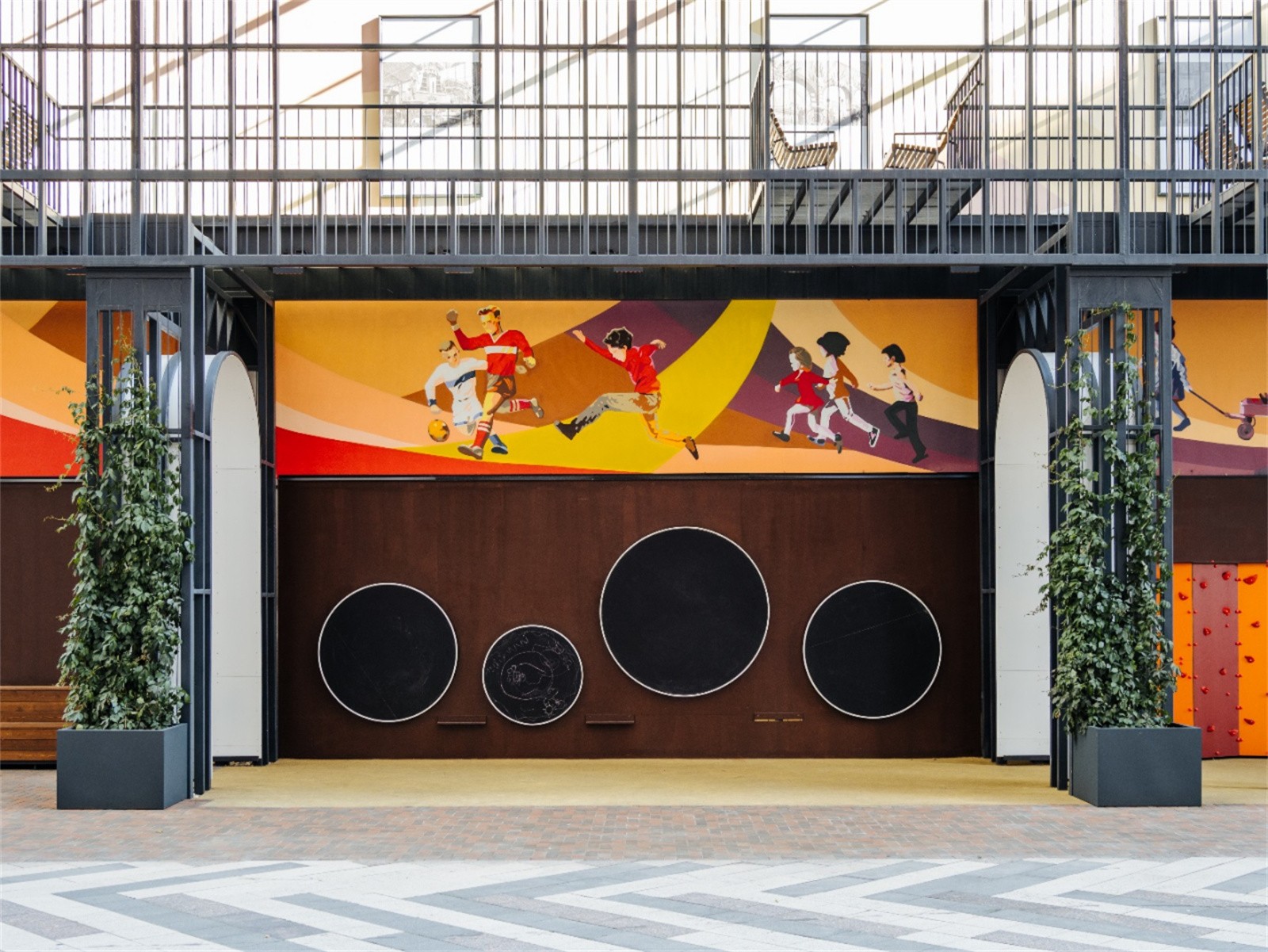
專為住宅居民設(shè)計(jì)的綠洲庭院以特殊的構(gòu)成手法設(shè)計(jì)����,采用了多個(gè)形狀各異的五邊形。由于庭院的這種分隔形式���,空間在視覺(jué)效果上被擴(kuò)大�,也看起來(lái)更加復(fù)雜多樣�����。種植池也作為裝飾物裝點(diǎn)了庭院景觀����。
The oasis-yards are allocated exclusively for the complex residents. A special pattern of variously shaped pentagons was created for the yards. Due to such separation of the yards, the space enlarges visually and looks more complex. The planter boxes also shape an ornament.
▼由多個(gè)形狀各異的五邊形組成的綠洲庭院
The oasis-yards is composed of variously shaped pentagons. ? Dmitry Tchistoprudov


每個(gè)庭院中都設(shè)置有帶秋千的涼廊���,帶吧臺(tái)的圓形劇場(chǎng)以及兒童小型游樂(lè)場(chǎng)。項(xiàng)目旨在打造人性化尺度���、體驗(yàn)舒適的居住環(huán)境��。
Each yard has a pergola with swings, amphitheatre with a bar stand and a small playground for kids. We were aiming to create an atmosphere of a cozy yard comparable in size with the people in it.
▼帶有秋千的涼廊
The pergola with swings ? Dmitry Tchistoprudov
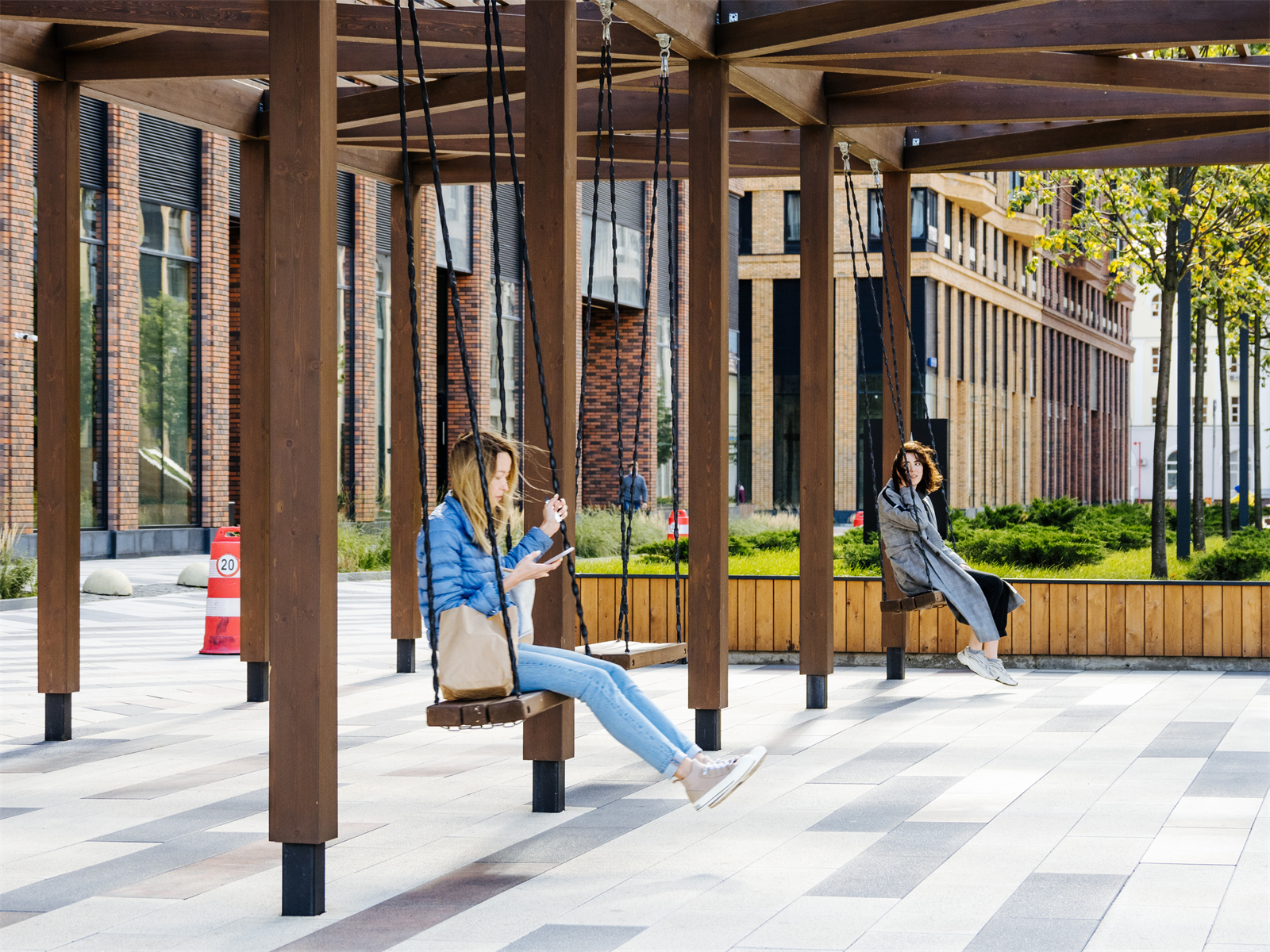
▼帶來(lái)舒適體驗(yàn)的庭院環(huán)境
The yard brings cozy experience. ? Dmitry Tchistoprudov

現(xiàn)在場(chǎng)地內(nèi)還增設(shè)了微地形兒童趣味活動(dòng)區(qū)和一處遠(yuǎn)離車行道��、被小丘與灌木包圍的安靜運(yùn)動(dòng)區(qū)�����。這些區(qū)域不僅可供綜合體居民使用���,也對(duì)臨近住宅區(qū)的居民開(kāi)放。
The territory now also enjoys a kids’ zone with geoplastic and a sports zone protected from the driveway area by the hills with bushes and trees. These sites are available not only to the complex residents but also to the residents of the neighbouring houses.
▼微地形兒童活動(dòng)區(qū)
Thea kids’ zone with geoplastic ? Dmitry Tchistoprudov

▼被小丘與灌木包圍的運(yùn)動(dòng)區(qū)
A sports zone surrounded by the hills with bushes and trees ? Dmitry Tchistoprudov

地面的浮雕與鋪裝的圖案塑造了獨(dú)特且引人注目的空間圖像���。這些區(qū)域被景觀劃分成塊��,除了使基礎(chǔ)設(shè)施的位置多元化之外��,也給予了兒童與青少年充分的自由去設(shè)計(jì)對(duì)這些空間場(chǎng)景的使用方式�����。
The relief of the site as well as the pattern of the pavement shape a unique and an eye-catching image of the space. These areas are split into zones by the landscaping, which in addition to the unusual location of the equipment lets you make up your own scenarios of using these spaces for kids and teenagers.
▼景觀細(xì)部
The landscape details ? Dmitry Tchistoprudov

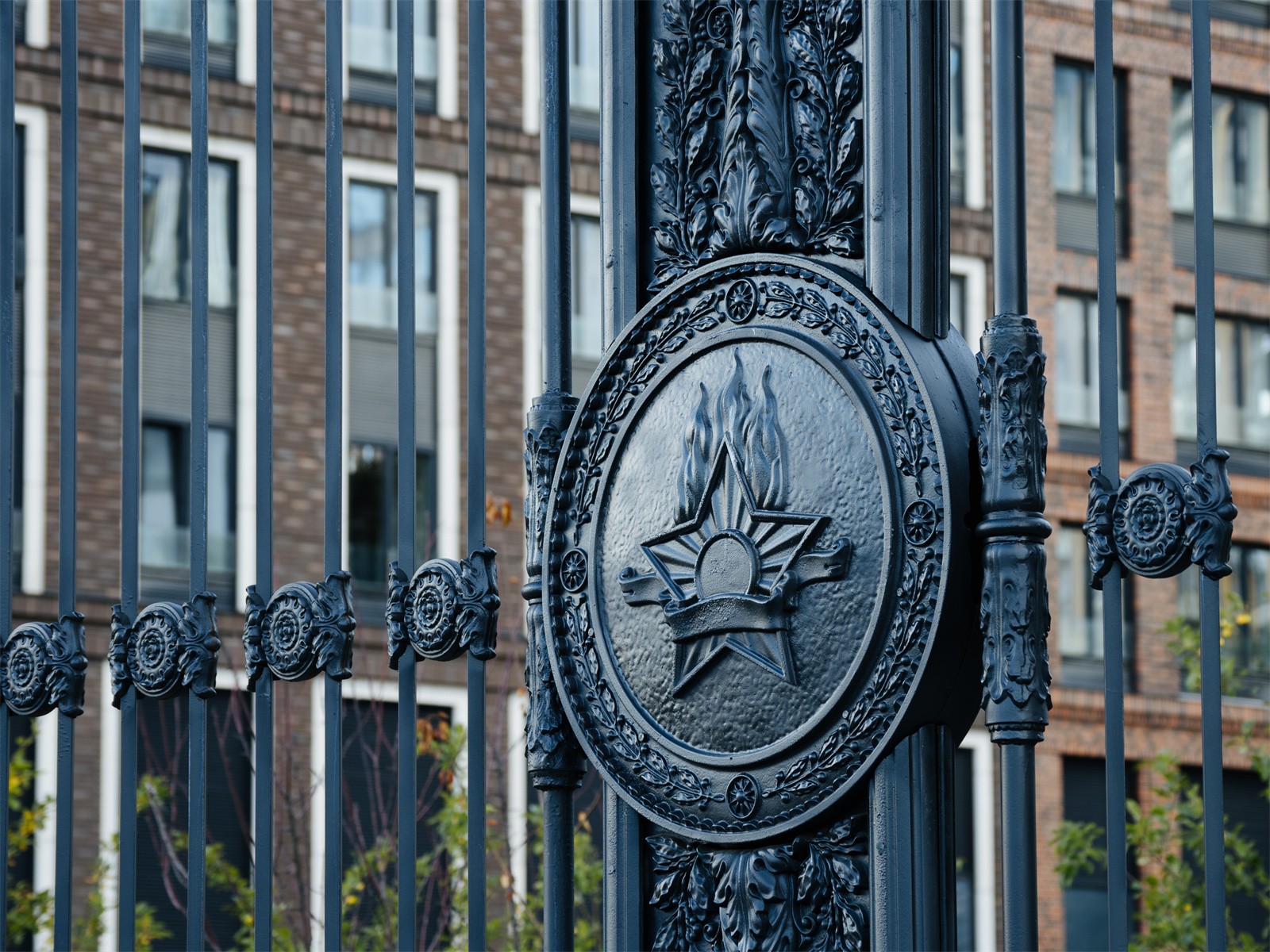
▼總平面圖
The overall site plan ? Wowhaus Bureau
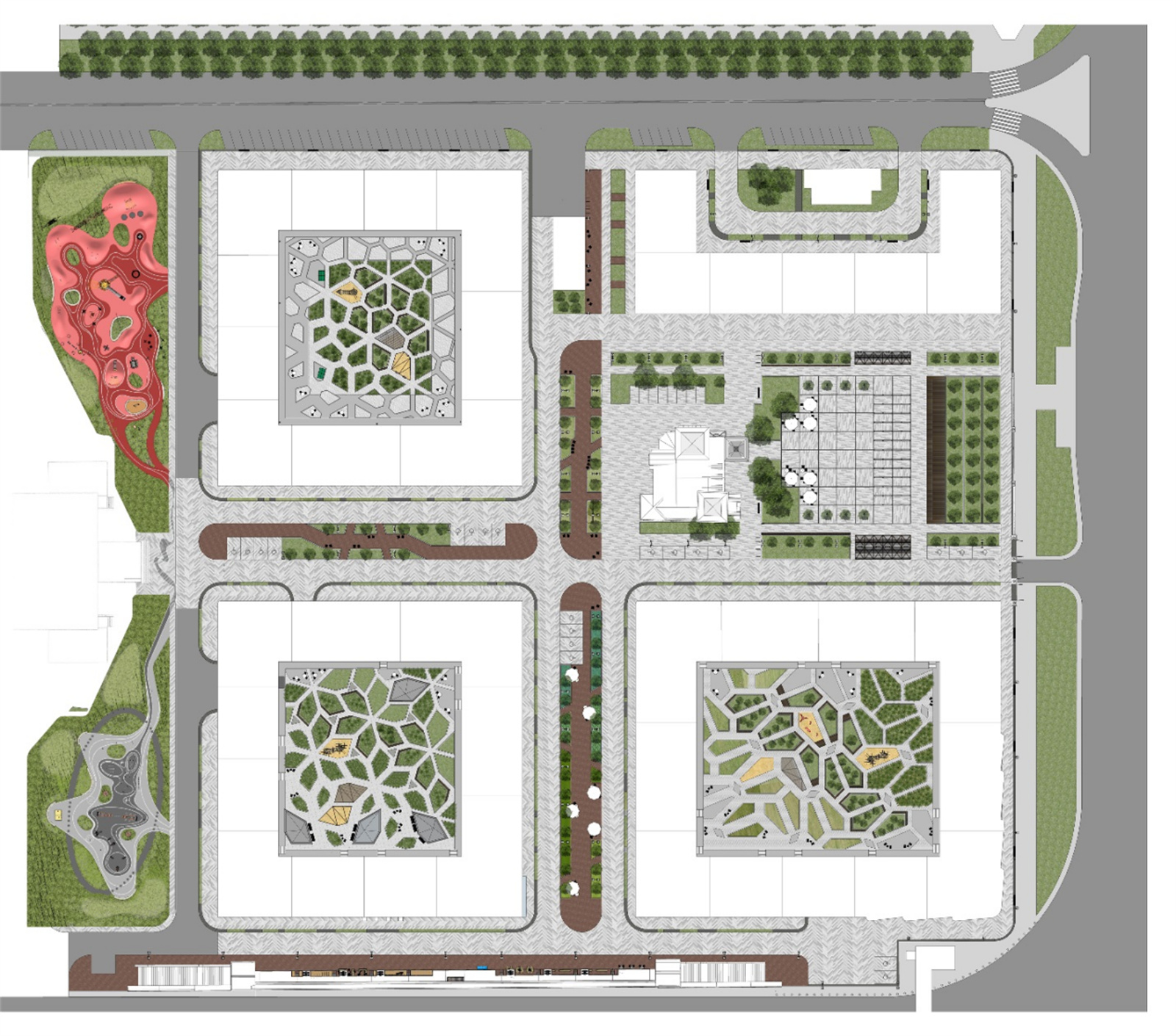
項(xiàng)目信息
項(xiàng)目名稱:莫斯科Tsarskaya ploschad住宅綜合體開(kāi)發(fā)
項(xiàng)目地點(diǎn):俄羅斯�����,莫斯科列寧格勒斯基大道31號(hào)
總體規(guī)模:4公頃
承包商:MR Group
設(shè)計(jì)公司:Wowhaus Bureau
主策劃:Dmitry Likin, Oleg Shapiro
主創(chuàng)建筑師:Alyona Zaitseva, Ivan Krasheninnikov, Marina Yarmarkina
建筑師:Ivan Korenkov; with the participation of Anastasia Grishina, Pavel Zeldovich, Yekaterina Sporykhina
景觀開(kāi)發(fā):Arbor group
照明設(shè)計(jì):Light Culture
涂鴉設(shè)計(jì):Raskrasimvse
設(shè)計(jì)周期:2015-2020
建造周期:2016-2020
圖片來(lái)源:Dmitry Tchistoprudov
Project Name:Development of the Tsarskaya ploschad residential complex in Moscow
Project Location:Leningradsky prospect, estate 31, Moscow
General area of development: 4 hectares
Contractor: MR Group
Design Company:Wowhaus Bureau
Masterminds: Dmitry Likin, Oleg Shapiro
Lead Architects: Alyona Zaitseva, Ivan Krasheninnikov, Marina Yarmarkina
Architects: Ivan Korenkov; with the participation of Anastasia Grishina, Pavel Zeldovich, Yekaterina Sporykhina
Landscape Development: Arbor group
Lightening: Light Culture
Graffiti: Raskrasimvse
Designing: 2015-2020
Implementation: 2016-2020
Photo: Dmitry Tchistoprudov
翻譯&排版:胡碧喬
版權(quán)聲明:本文版權(quán)歸原作者所有��,請(qǐng)勿以景觀中國(guó)編輯版本轉(zhuǎn)載�����。如有侵犯您的權(quán)益請(qǐng)及時(shí)聯(lián)系�,我們將第一時(shí)間刪除����。
投稿郵箱:info@landscape.cn
項(xiàng)目咨詢:18510568018(微信同號(hào))
 京公海網(wǎng)安備 110108000058號(hào)
京公海網(wǎng)安備 110108000058號(hào)























